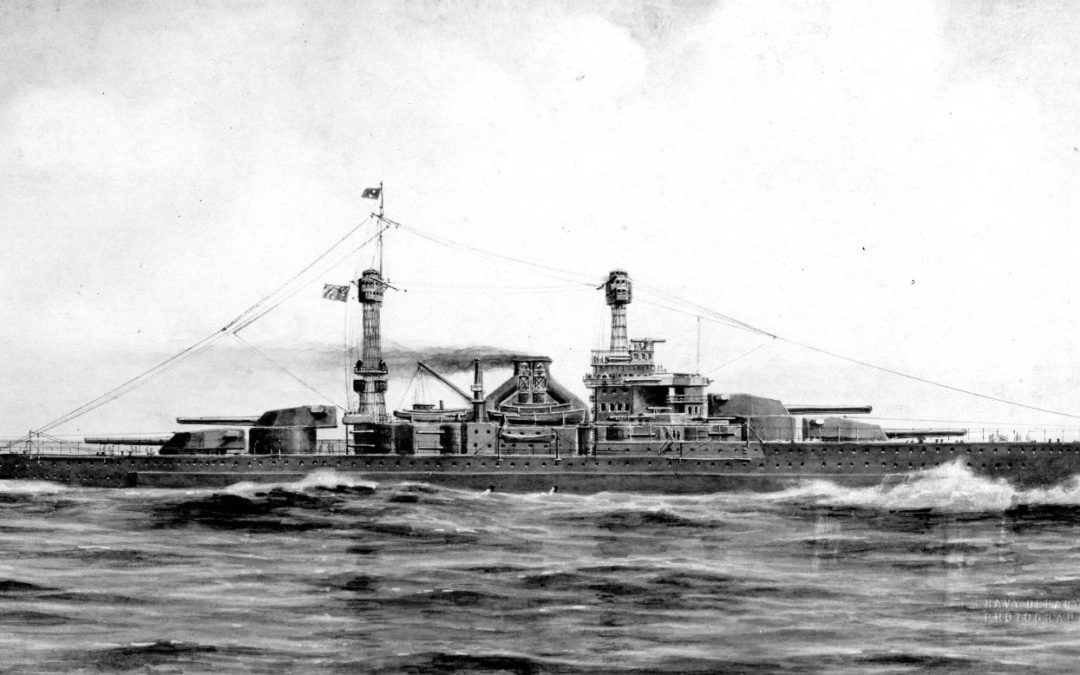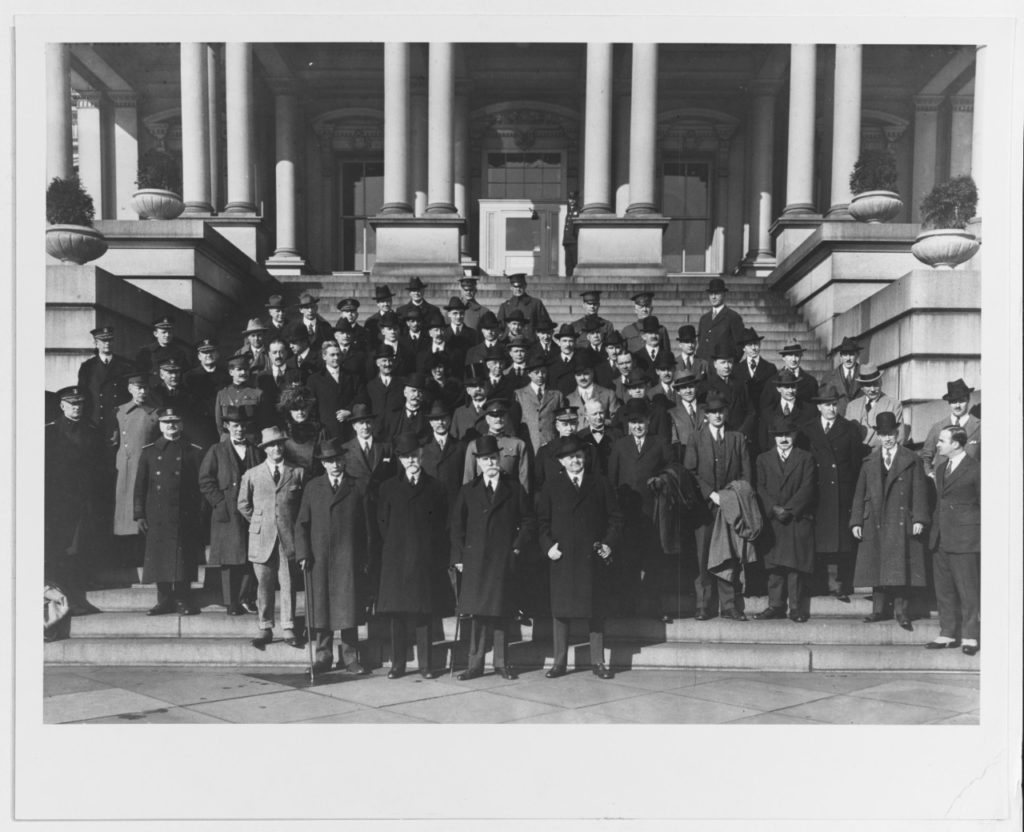It is a century since the world’s leading powers negotiated the ‘Washington Treaty’. This agreement of 6 February 1922 – called the ‘Five Power Treaty’ at the time[1] – required signatories to scrap numerous ships, including some as yet unfinished, dictated strict limits to naval armaments and imposed a ten-year ‘holiday’ on capital ship construction.
It was first time naval armaments had been limited by international agreement rather than the usual framework of political debate, national priorities, economic strength and industrial capacity, which had broadly constrained the pre-war Anglo-German naval race. That begs a question – why did some of the world’s most powerful nations come together, just then in 1921-22, to agree?
The answers, however, are not hard to find. The warring nations were emotionally and financially exhausted. The pre-war international order had gone and the diplomatic landscape was very different from what it had been in 1913. This had not, however, reduced implict tensions between the major powers. Although relations between Britain and the United States were excellent, Congress had authorised a massive naval build-up in 1916, mainly directed at Japan but implicitly challenging the Royal Navy’s superiority.[2] For an article on the battlecruiser side of that programme, click here. This general programme became a sticking point in early 1919 when British and United States delegates met in Paris to discuss a peace treaty with Germany and discussion turned to post-war power balances and relationships.[3]
The US build-up inevitably triggered a naval race with Japan, who responded with a major building programme involving capital ships of unprecedented size and power – and this despite Japan having a gross national product only about a tenth that of their rival.[4]
Britain’s problem was penury. War’s end saw wholesale demobilisation. Older ships were swiftly put into reserve or sold, and as early as 1919 the Chancellor of the Exchequer, Austin Chamberlain, pressed to cut the Royal Navy to just 15 capital ships for financial reasons.[5] The Prime Minister, David Lloyd-George, was also opposed to capital ship programmes and refused to authorise new construction, anticipating an international arrangement might be made. There’s an article on the issue here.
He was not the only politician thinking along these lines. In the United States, proposals for further expansion to match Japan’s build-up were floated. However, there was little political appetite to extend the 1916 plan, particularly as the US economy crashed into depression in 1920-21 when the brief post-war boom ended. That brought a 17-percent drop in gross domestic product over 14 months,[6] and in December 1920, Congress failed to pass a vote that would have enabled further funding of the 1916 programme.[7] Idaho senator William Borah then introduced a motion calling on the US, Britain and Japan to cut their naval construction programmes by half – this on the same day that Secretary of the Navy Josephus Daniels was giving testimony to the House Armed Services Committee in favour of the 1916 programme. By this time the US had a new President-elect, Warren Harding, voted in on a platform of fiscal cuts.
This mood was generally shared among the major powers. As early as January 1921 the Japanese Prime Minister, Hara Takahashi, declared that while Japan did not intend falling behind, they would ‘gladly’ enter into an arms limitation agreement. [8] The point was tacit admission that their naval build-up was unaffordable. Japanese naval spending had soared from 83 million yen in 1914 to 484 million in 1921,[9] absorbing about a third of Japan’s fiscal budget. But by then the wartime prosperity bubble had collapsed. The battleship Mutsu – approaching completion as negotiators gathered in Washington – was partly funded by public subscription, and work was under way on her successors; but Japan could not really afford the programme. A disarmament conference offered a negotiated way out.
The pressure for a conference grew that year. By 1921 Britain was confronting its own economic crunch, which came on top of the wide range of post-war issues the Lloyd-George administration had to tackle, including the Irish civil war and Lord Rothermere’s loud ‘anti-waste league’. Other trouble brewed across the Empire. The issue, as the Foreign Secretary Lord Curzon remarked during the Imperial Conference of mid-1921, was ‘to keep what we have obtained’.[10] The problem, as always, was less the cost of major government programmes as meeting interest costs on the loans raised to fund them; Britain had emerged from war with crippling debt. Interest alone was around a million pounds a day.
Lloyd-George set up a Committee on National Expenditure under Sir Eric Geddes to find efficiencies: and to them, defence spending was a soft target. The cost was ceding naval superiority to the United States, but one the Lloyd-George government was prepared to accept. However, a treaty offered potential for negotiated parity. In March and again in April 1921, Britain’s First Lord of the Admiralty, Arthur Lee, made explicit that Britain was ready to discuss naval disarmament with the United States.
Harding did not act until early July, when he asked the State Department to canvass opinion among the ‘Principal Allied and Associated Powers’ for an international disarmament conference.[11] The conference turned out to be more wide-ranging: the naval race with Japan was tied up with power balances in Asia, and many other issues remained to be dealt with. So the conference became far broader than simply a naval discussion. Harding had official invitations issued in August, drawing in nine world powers: besides the United States, Britain and Japan there were France and Italy, Belgium, China, Portugal and The Netherlands. Alongside the naval treaty and other agreements associated with warfare, the diplomats had the task of re-defining world power balances and treaty arrangements in what was then called the ‘Far East’.
The conference was due to begin on 11 November 1921, but was delayed a day so that diplomats could attend memorial services. The conference continued until 6 February 1922, producing produced multiple treaties that shaped the early inter-war power balances. These included a Four Power Treaty replacing the Anglo-Japanese alliance, the Five Power Treaty on naval arms limitation, and a Nine Power Treaty that pledged independence for China. The naval treaty was signed by Britain, the United States, France, Italy, Japan – and, separately, Britain’s self-governing Dominions, New Zealand, Australia, Canada and South Africa.[12] It was one of the key results of these discussions and became ‘the’ Washington Treaty. We will explore that in detail in the next article. Watch this space.
Meanwhile, for more on naval history, my book on HMS New Zealand is published by Seaforth and USNI Press. Check it out.
[1] See, e.g. https://history.state.gov/milestones/1921-1936/naval-conference
[2] Robert Stern, The Battleship Holiday, Seaforth, Barnsley 2017, p.86.
[3] Norman Friedman ‘How promise turned to disappointment’, Naval History Magazine, Vol. 30, No. 4, August 2016.
[4] Calculated in William D. O’Neill ‘Interwar YS and Japanese National Product and Defense Expenditure’, CNA, Virginia, 2003, p. 15.
[5] Christopher M. Bell, Churchill and Sea Power, Oxford University Press, Oxford 2013, p. 89.
[6] https://mises.org/library/forgotten-depression-1920, accessed 13 January 2020.
[7] Stern, p. 99.
[8] Stern, pp. 98-99.
[9] George Modelski and William R. Thompson, Sea Power in Global Politics 1494-1973, Palgrave MacMillan 1988, p. 341.
[10] Cited in Erik Goldstein, ‘British Diplomatic Strategy’, in Erik Goldstein and John Maurer (eds), The Washington Conference 1921-22: naval rivalry, East Asian stability and the road to Pearl Harbor, Routledge, London 1994, reprint 2002, p. 6.
[11] ‘Conference on the Limitation of Armament’, The American Journal of International Law, Vol. 16, No. 2, April 1922, p. 159.
[12] ‘Limitation of Naval Armament (Five Power Treaty or Washington Treaty), at https://www.loc.gov/law/help/us-treaties/bevans/m-ust000002-0351.pdf, accessed 8 February 2021.






Recent Comments